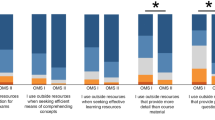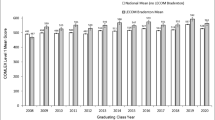Abstract
Purpose
To describe medical students’ reading habits and resources used during clinical clerkships, and to assess whether these are associated with performance outcomes.
Method
Authors administered a cross-sectional survey to medical students at 3 schools midway through the clerkship year. Closed and open-ended questions focused on resources used to read and learn during the most recent clerkship, time spent and purpose for using these resources, influencers on study habits, and barriers. A multiple regression model was used to predict performance outcomes.
Results
Overall response rate was 53% (158/293). Students spent most of their time studying for clerkship exams and rated question banks and board review books as most useful for exam preparation. Sixty-seven percent used textbooks (including pocket-size). For patient care, online databases and pocket-sized textbooks were rated most useful. The main barrier to reading was time. Eighty percent of students ranked classmates/senior students as most influential regarding recommended resources. Hours spent reading for exams was the only significant predictor of USMLE Step 2 scores related to study habits. The predominant advice offered to future students was to read.
Conclusions
These findings can help inform students and educational leadership about resources students use, how they use them, and links to performance outcomes, in an effort to guide them on maximizing learning on busy clerkships. With peers being most influential, it is important not only to provide time to help students build strong reading and study habits early, but also to guide them towards reliable resources, so they will recommend useful information to others.




Similar content being viewed by others

Availability of Data and Material
Deidentified survey response data available upon request.
Code Availability
Survey administered using Qualtrics.
References
Liaison Committee on Medical Education: functions and structure of a medical school standards for accreditation of medical education programs leading to the MD degree. https://lcme.org/publications/ Accessed October 2020.
Leff B, Harper GM. The reading habits of medicine clerks at one medical school: frequency, usefulness, and difficulties. Acad Med. 2006;81(5):489–94. https://doi.org/10.1097/01.ACM.0000222273.90705.a6.
Watling C, Driessen E, van der Vleuten CP, Vanstone M, Lingard L. Beyond individualism: professional culture and its influence on feedback. Med Educ. 2013;47(6):585–94. https://doi.org/10.1080/09638288.2021.1891304.
Robinson EJ, Einav S, Fox A. Reading to learn: prereaders’ and early readers’ trust in text as a source of knowledge. Dev Psychol. 2013;49(3):505–13. https://doi.org/10.1037/a0029494.
Cooper AL, Elnicki DM. Resource utilization patterns of third-year medical students. Clin Teach. 2011;8(1):43–7. https://doi.org/10.1111/j.1743-498X.2010.00393.x.
DeZee KJ, Durning S, Denton GD. Effect of electronic versus print format and different reading resources on knowledge acquisition in the third-year medicine clerkship. Teaching and Learning in Medicine, An International Journal. 2005;17(4):349–54. https://doi.org/10.1207/s15328015tlm1704_7.
Fafard J, Snell L. Reading habits of house-staff: what, where and why. Med Teach. 1989;11(3–4):279–83. https://doi.org/10.3109/01421598909146413.
Lai CJ, Aagaard E, Brandenburg S, Nadkarni M, Wei HG, Baron R. Brief report: Multiprogram evaluation of reading habits of primary care internal medicine residents on ambulatory rotations. J Gen Intern Med. 2006;21(5):486–9. https://doi.org/10.1111/j.1525-1497.2006.00432.x.
Johnson KH, Dayrit M, Bazargan M. The reading habits of family practice residents. Fam Med. 1997;29(7):488–91.
Kim JJ, Kim DY, Kaji AH, et al. Reading habits of general surgery residents and association with american board of surgery in-training examination performance. JAMA Surg. 2015;150(9):882–9. https://doi.org/10.1001/jamasurg.2015.1698.
Clark C, Rumbold K. Reading for pleasure: a research overview. Natl Lit Trust. 2006;1–35. https://doi.org/10.1037/h0037910
Mak HW, Fancourt D. Longitudinal associations between reading for pleasure and child maladjustment: Results from a propensity score matching analysis. Soc Sci Med. 2020;253:112971. https://doi.org/10.1016/j.socscimed.2020.112971.
Watson EM. The importance of leisure reading to health sciences students: results of a survey. Health Info Libr J. 2016;33(1):33–48. https://doi.org/10.1111/hir.12129.
Bulte C, Betts A, Garner K, Durning S. Student teaching: views of student near-peer teachers and learners. Med Teach. 2007;29(6):583–90. https://doi.org/10.1080/01421590701583824.
Lockspeiser TM, O’Sullivan P, Teherani A, Muller J. Understanding the experience of being taught by peers: the value of social and cognitive congruence. Adv Health Sci Educ Theory Pract. 2008;13(3):361–72. https://doi.org/10.1007/s10459-006-9049-8.
Wynter L, Burgess A, Kalman E, Heron JE, Bleasel J. Medical students: what educational resources are they using? BMC Med Educ. 2019;19:36. https://doi.org/10.1186/s12909-019-1462-9.
Author information
Authors and Affiliations
Contributions
All authors contributed substantially to the manuscript warranting authorship as per ICMJE guidelines, i.e., to the study conception/design or acquisition, analysis, or interpretation of the data, drafting/revising, providing final approval, and are ensuring accountability.
Corresponding author
Ethics declarations
Ethics Approval
This study was approved as exempt by the Institutional Review Boards at each participating institution, with The George Washington University Office of Human Research serving as the lead. Consent from participants was obtained electronically.
Conflict of Interest
The authors declare no competing interests.
Additional information
Publisher's Note
Springer Nature remains neutral with regard to jurisdictional claims in published maps and institutional affiliations.
Rights and permissions
About this article
Cite this article
Kind, T., Olvet, D.M., Farina, G. et al. Reading and Study Habits of Medical Students on Clerkships and Performance Outcomes: a Multi-institutional Study. Med.Sci.Educ. 31, 1957–1966 (2021). https://doi.org/10.1007/s40670-021-01409-5
Accepted:
Published:
Issue Date:
DOI: https://doi.org/10.1007/s40670-021-01409-5



